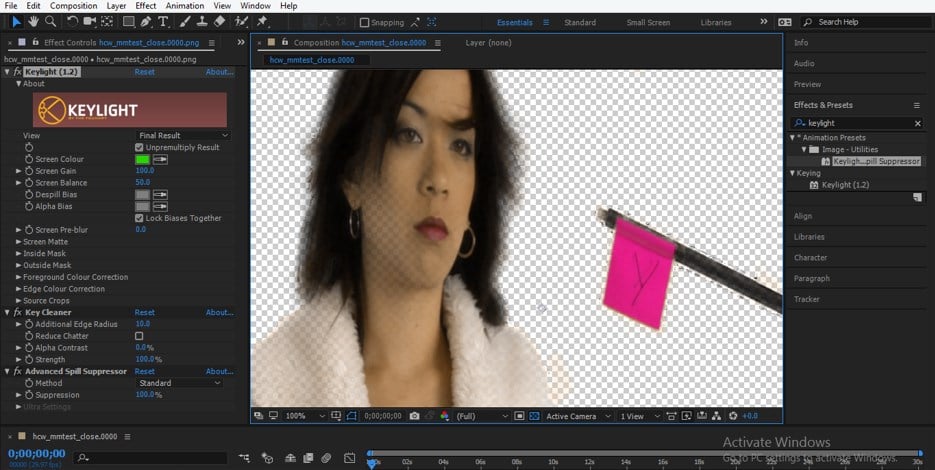

- #KEYLIGHT 1.2 DOWNLOAD FOR CC MOVIE#
- #KEYLIGHT 1.2 DOWNLOAD FOR CC SOFTWARE#
- #KEYLIGHT 1.2 DOWNLOAD FOR CC WINDOWS#
Mercury Transmit is a software interface that Adobe digital video applications use to send video frames to external video displays. For instructions on calibrating a computer monitor, see After Effects Help. Always be sure your video or computer monitor is properly calibrated before performing color correction. What may look good on a computer screen may be too bright and washed out on a broadcast monitor. The gamma values between a computer monitor and a broadcast monitor vary greatly. If possible, perform color correction on a video monitor instead of a computer monitor. Previewing your project on a video monitor You specified an overlap of 18 frames and a cross-dissolve transition so that the first clip dissolves into the second. When Sequence Layers is selected, After Effects places the layers in sequence rather than placing them both to start at 0:00. Choose Dissolve Front Layer from the Transition menu.In the Options area, choose superkid_01.mov from the Use Dimensions From menu.Make sure Single Composition is selected.In the New Composition From Selection dialog box, do the following: Select the superkid_01.mov file and Shift-click the superkid_02.mov file, and drag the files onto the Create A New Composition button ( ) at the bottom of the Project panel.Ĥ. In the Project panel, deselect the assets you imported. Navigate to the Lessons/Lesson10/Assets folder, Shift-click to select the storm_clouds.jpg, superkid_01.mov, and superkid_02.mov files, and then click Import or Open.ģ.
#KEYLIGHT 1.2 DOWNLOAD FOR CC MOVIE#
You’ll create a new composition based on the two superkid movie files.Ģ. Name the project Lesson10_Finished.aep, and then click Save. In the Save As dialog box, navigate to the Lessons/Lesson10/Finished_Project folder.Ħ. Close the Start window.Īfter Effects opens to display an empty, untitled project.ĥ.


When prompted, click OK to delete your preferences. Start After Effects, and then immediately hold down Ctrl+Alt+Shift (Windows) or Command+Option+Shift (Mac OS). See “ Restoring default preferences” on page 2.ģ. When you begin this lesson, restore the default application settings for After Effects. You may delete the sample movies from your hard disk if you have limited storage space.
#KEYLIGHT 1.2 DOWNLOAD FOR CC WINDOWS#
When you are done, close Windows Media Player or QuickTime Player. Open and play the Lesson10.avi sample movie in Windows Media Player or the Lesson10.mov sample movie in QuickTime Player to see what you will create in this lesson. In the Sample_Movies folder: Lesson10.avi, Lesson10.movĢ.In the Assets folder: storm_clouds.jpg, superkid_01.mov, superkid_02.mov.Make sure the following files are in the Lessons/Lesson10 folder on your hard disk, or download them from your Account page at now: You’ll also use mask tracking and motion tracking to replace the sky with more dramatic clouds.įirst, you’ll preview the final movie and set up your project.ġ. Then, you’ll apply a variety of color-correction effects to clean up and enhance the image. First, you’ll combine two clips from a longer video of a young superhero taking off and flying through the sky. In this lesson, you will correct the color of a video clip that was shot without the proper white-balance setting. However, you can use the same color-correction tools and techniques to perform color grading, which is the subjective manipulation of color to focus attention on a key element in a shot or create a color palette for a specific visual look. Strictly speaking, color correction is the act of adjusting the color in a shot to correct errors in white balance and exposure, and to ensure color consistency from one shot to another. With Adobe After Effects, you can easily remove color casts, brighten images, and change the mood of a clip.Īs the term implies, color correction is a way of altering or adapting the color of a captured image. Most shots require some degree of color correction and color grading.


 0 kommentar(er)
0 kommentar(er)
